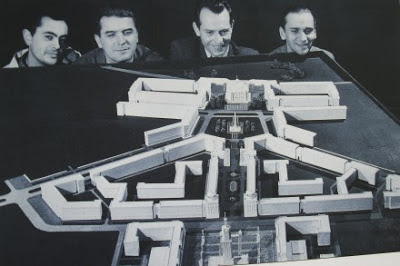Nowa Huta, Poland
 |
| A model of the ideal Soviet city and its proud planners |
“…Nowa Huta (city in Poland) – Polish for ‘new steelworks’ — had been planned as a model socialist community (one of only two entirely pre-planned socialist realist cities ever built—the other being Magnitogorsk in Russia’s Ural Mountains). Poland’s rulers had wanted a socioeconomic laboratory where they could turn God-fearing Polish peasants into the new proletarian man described by Marx and Lenin…
The decision to build Nowa Huta was rubber stamped on May 17, 1947 and over the next few years construction of a model city for 100,000 people sprung up at breakneck speed. Built to impress, Nowa Huta featured wide, tree-lined avenues, parks, lakes and the officially sanctioned architectural style of the time - Socialist Realism. Nowa Huta’s architects strove to construct the ideal city, with ironic inspiration coming from the neighbourhood blocks built in 1920’s New York. Careful planning was key, and the suburb was designed with ‘efficient mutual control' in mind: wide streets would prevent the spread of fire and the profusion of trees would easily soak up a nuclear blast, while the layout was such that the city could easily be turned into a fortress if it came under attack.
The construction of Nowa Huta …was accompanied by a propaganda barrage about the incredible feats of ‘heroes of socialist labor’... To celebrate its completion, the giant Nowa Huta steelworks received the hallowed name of Lenin…
Nowa Huta differed from other model socialist towns in one very important respect. At the corner of Karl Marx Avenue and Great Proletarian Avenue stood a soaring concrete structure that had not been part of the original plan. Topped by a huge steel cross, the Church of Our Lady, Queen of Poland was known to everyone in town as the ‘The Lord’s Ark.’ The struggle to prove the planners wrong had infused the entire community with a sense of defiance.
The first cross appeared on this site in 1957, in the wake of the popular upheavals that swept Gormulka to power. Over the next decade the cross was repeatedly torn down by police and stubbornly put up again by the local inhabitants. Finally, in 1967, seventeen years after the building of Nowa Huta, the archibishop of Krakow had dug a spade into the earth to break the ground for the town’s first church. It took another decade of bureaucratic obstruction and arbitrary shortages of building materials to complete The Lord’s Ark. Much of the work, including carrying two million stones from mountain streams, was done by local inhabitants with their bare hands. ...[I]n 1977, the archbishop had declared: ‘Nowa Huta was built as a city without God, but the will of God and the people who worked here prevailed. Let this be a lesson.’
The archbishop [went] on to become Pope John Paul II, the first non-Italian pope in 455 years. …During [his] 1979 pilgrimage Pope John Paul …attacked the state for attempting to create an atheistic society. ‘Christ cannot be kept out of the history of man in any part of the globe,’ he had thundered. The crowd greeted his words with a ten-minute burst of applause, ending with rhythmic chants of ‘We want God, we want God!’
…In June, 1983, …on the last full day of his visit the pope said mass on the Blonie, the vast meadow in front of Wawel Castle …[to] the crowd of two million people. Alluding to Jaruzelski’s imposition of martial law, the pope urged his listeners never to give up. The nation had been ‘called to victory,’ he declared.
As he said these words, two million people raised their hands silently in the air in the V for victory sign. An underground Solidarity leader, Eugeniusz Szumiejko, who had managed to escape the police roundup, was standing at the back of the huge throng, on top of an embankment. All of a sudden he saw a sea of black heads submerged in a wave of white fists. It was an awe-inspiring sight, proof that Jaruzelski had been unable to crush the spirit that had given birth to solidarity. At the end of the mass a large chunk of the crowd set off on foot for Nowa Huta, beneath their solidarity banners, to see the pope consecrate a new church.
‘Khodz z namy,’ they chanted, the battle cry of 1970 and 1980. ‘Come with us. There will be no beatings today.’
When they reached the site of the new church, they joined a congregation of a quarter of a million people. The entire population of the ‘city without God’ had turned out to greet the pope. Here was proof that history could not be reversed by tanks, internment camps, and corrugated iron fences, that martial law too would pass, and that Nowa Huta’s two-story monument to the founder of world communism would one day come down.”
 |
| 'The Lord's Ark' (source: wikimedia.org) |
~Excerpts from Michael Dobbs (Down with Big Brother: The Fall of the Soviet Empire) & the site “In Your Pocket: Essential City Guides”
Comments